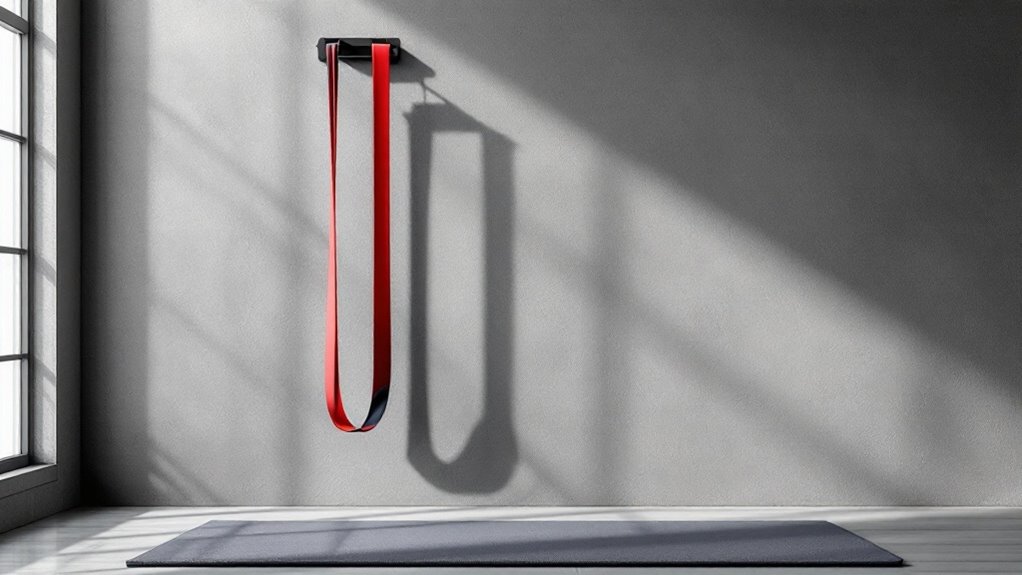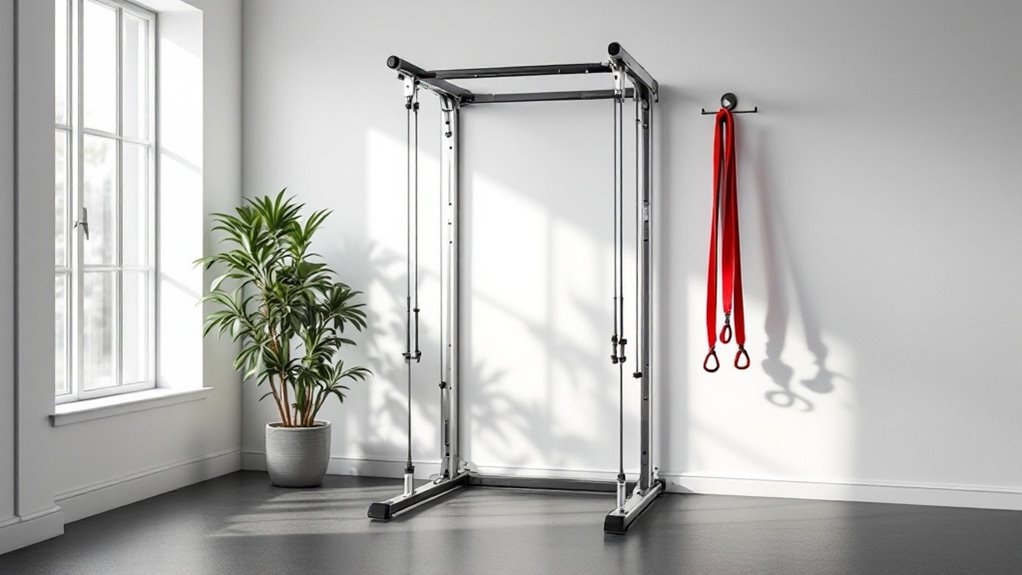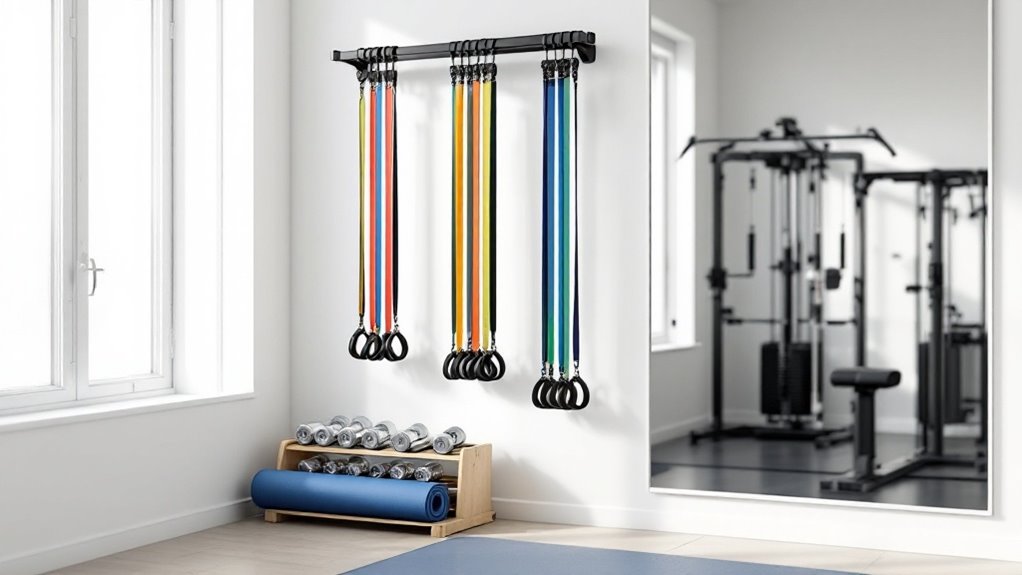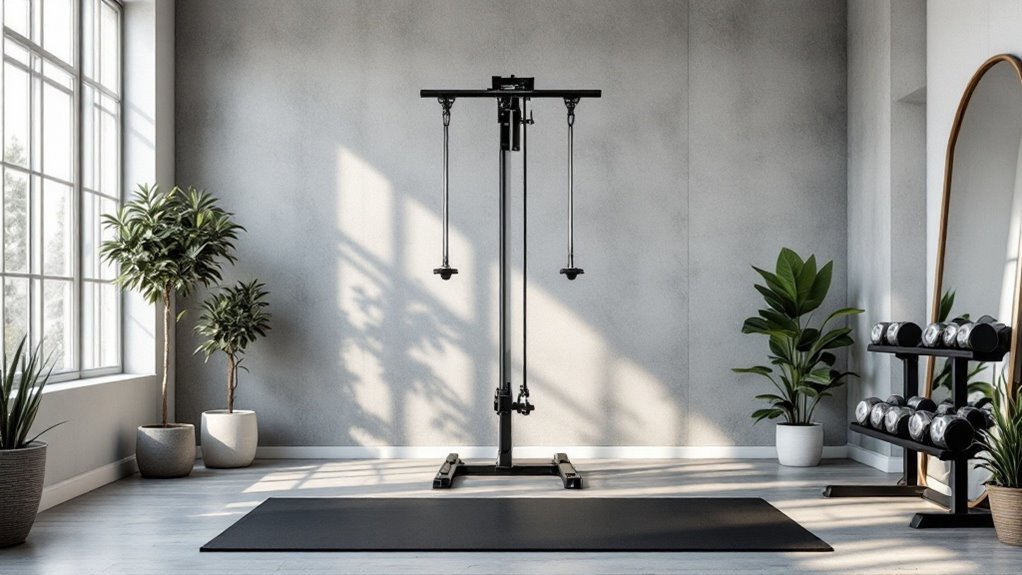Standing Chest Workouts

Standing chest workouts combine functional strength and athletic development by engaging multiple muscle groups simultaneously. These exercises utilize resistance bands, cables, or bodyweight movements to target the chest while improving core stability and balance. The vertical orientation increases caloric burn and muscle activation throughout the kinetic chain compared to traditional bench exercises. Proper form and progressive overload principles guarantee peak results. Exploring these movements reveals new dimensions of upper body development.
Key Takeaways
- Standing cable chest presses target pectoral muscles while engaging core stabilizers for functional strength and improved posture.
- Resistance band chest flyes effectively work outer chest muscles and can be performed anywhere with minimal equipment.
- Standing exercises burn more calories than bench exercises by recruiting additional muscle fibers throughout the body.
- Maintain shoulder retraction and core engagement during all standing chest movements to ensure proper form and stability.
- Progress gradually with resistance levels while mastering proper technique to build sustainable strength and prevent injury.
Benefits of Standing Chest Exercises

Standing chest exercises offer a unique set of advantages that make them valuable additions to any strength training routine. These movements involve the core stabilizing muscles, improving overall balance and functional strength while targeting the pectoral muscles.
They also improve athletic performance by mimicking real-world pushing movements. Unlike bench exercises, standing variations create greater muscle activation through the entire kinetic chain.
The vertical orientation challenges the body's stabilizing systems, recruiting more muscle fibers and burning additional calories. For athletes and fitness enthusiasts seeking thorough chest development, standing exercises provide practical, functional strength that translates directly to daily activities and sports performance.
Additionally, resistance band presses can be easily performed in limited spaces while maintaining proper form and engagement of the chest muscles.
Essential Standing Chest Movements

Three foundational movements form the core of any effective standing chest workout routine.
The standing cable chest press targets the entire pectoral region while maintaining proper posture.
Standing cable chest presses provide comprehensive pectoral development while keeping your spine aligned and supporting natural biomechanics.
Band or cable chest flyes activate the outer chest while improving stabilization and control.
Standing resistance push-ups against a wall or sturdy surface build foundational strength for beginners.
These movements combine to create a thorough chest-building arsenal that can be performed without a bench or floor space.
When executed with proper form and progressive overload principles, these exercises develop strength, muscle mass, and functional pushing power for everyday activities.
Creating a dedicated exercise space at home ensures consistent and focused chest training sessions without distractions.
Equipment and Setup Guide

A well-equipped standing chest workout requires minimal yet strategic gear selection. Essential items include resistance bands of varying tensions, a sturdy door anchor or mounting point, and adjustable cable machines if working out at a gym.
Dumbbells and resistance plates complement the setup for additional exercise variations.
For home workouts, investing in quality resistance bands with handles and a reliable mounting system is vital. The setup area should have adequate space for full range of motion and proper form execution.
A non-slip exercise mat provides stable footing, while a mirror helps monitor form during movements.
Following the principles of progressive overload through gradually increasing resistance levels is crucial for achieving optimal muscle growth and development.
Training Tips and Form Fundamentals

To optimize results during standing chest workouts, proper form and technique fundamentals must be mastered before increasing intensity or load.
Master the essentials of form and technique first – only then should you focus on adding weight or increasing workout intensity.
Maintaining correct posture and body positioning throughout each movement guarantees maximum muscle activation while preventing injury.
- Keep the core activated and shoulders pulled back during all exercises to maintain stability
- Control the eccentric (lowering) phase of movements for improved muscle fiber recruitment
- Breathe steadily – exhale during exertion and inhale during the return phase
- Focus on feeling the chest muscles contract through the full range of motion
These fundamentals lay the groundwork for effective chest development and should be prioritized over weight progression.
Following the principles of progressive overload allows beginners to systematically build strength while maintaining proper form.
Frequently Asked Questions
Can I Build a Bigger Chest Doing Only Standing Exercises?
Building a bigger chest through standing exercises alone is possible but suboptimal.
While exercises like standing cable flyes, resistance band presses, and landmine presses can target chest muscles, traditional movements like bench presses and floor presses provide better muscle activation and progressive overload potential.
Standing exercises should complement, not replace, proven horizontal pressing movements for maximum chest development.
How Long Should I Rest Between Standing Chest Exercise Sets?
Time is the silent architect of muscle growth.
For ideal chest development during standing exercises, rest periods should be 60-90 seconds between sets for hypertrophy-focused workouts. When training for strength, extend rest periods to 2-3 minutes.
Beginners might need longer rest intervals of 90-120 seconds to maintain proper form and technique while their bodies adapt to the movements.
Are Standing Chest Exercises Safe for People With Lower Back Problems?
Standing chest exercises can be safe for those with lower back problems when proper form and precautions are taken.
Individuals should maintain a neutral spine position, activate their core muscles, and avoid excessive arching.
It's recommended to start with lighter weights and consult a healthcare professional first.
Modified exercises or alternative chest workouts may be necessary depending on the specific back condition.
Should I Perform Standing Chest Exercises Before or After Bench Press?
Traditional bench press exercises should be performed before standing chest movements.
This sequence allows maximum force production when the body is fresh and stable.
Standing exercises, being more challenging for balance and coordination, are better suited as supplementary movements after the main pressing work is completed.
This approach optimizes strength gains while reducing injury risk and maintaining proper form throughout the workout.
Can Standing Chest Exercises Help Improve Posture and Rounded Shoulders?
Standing chest exercises effectively target the anterior muscles while promoting better posture and addressing rounded shoulders.
When performed correctly, these movements involve the pectorals and anterior deltoids while strengthening the upper back muscles that pull the shoulders into proper coordination.
The standing position naturally encourages better spinal coordination and core involvement, helping counteract the forward-hunched position many people develop from prolonged sitting and poor posture habits.
Final Thoughts
Standing chest workouts represent a dynamic progression in chest training, offering unique benefits beyond traditional bench exercises. Through proper form and consistent practice, these movements improve functional strength, improve posture, and involve stabilizing muscles often neglected in horizontal pressing. Evidence suggests that incorporating standing variations can lead to better muscle activation and real-world carryover. By mastering these fundamental movements, athletes can build a more resilient and balanced upper body.


